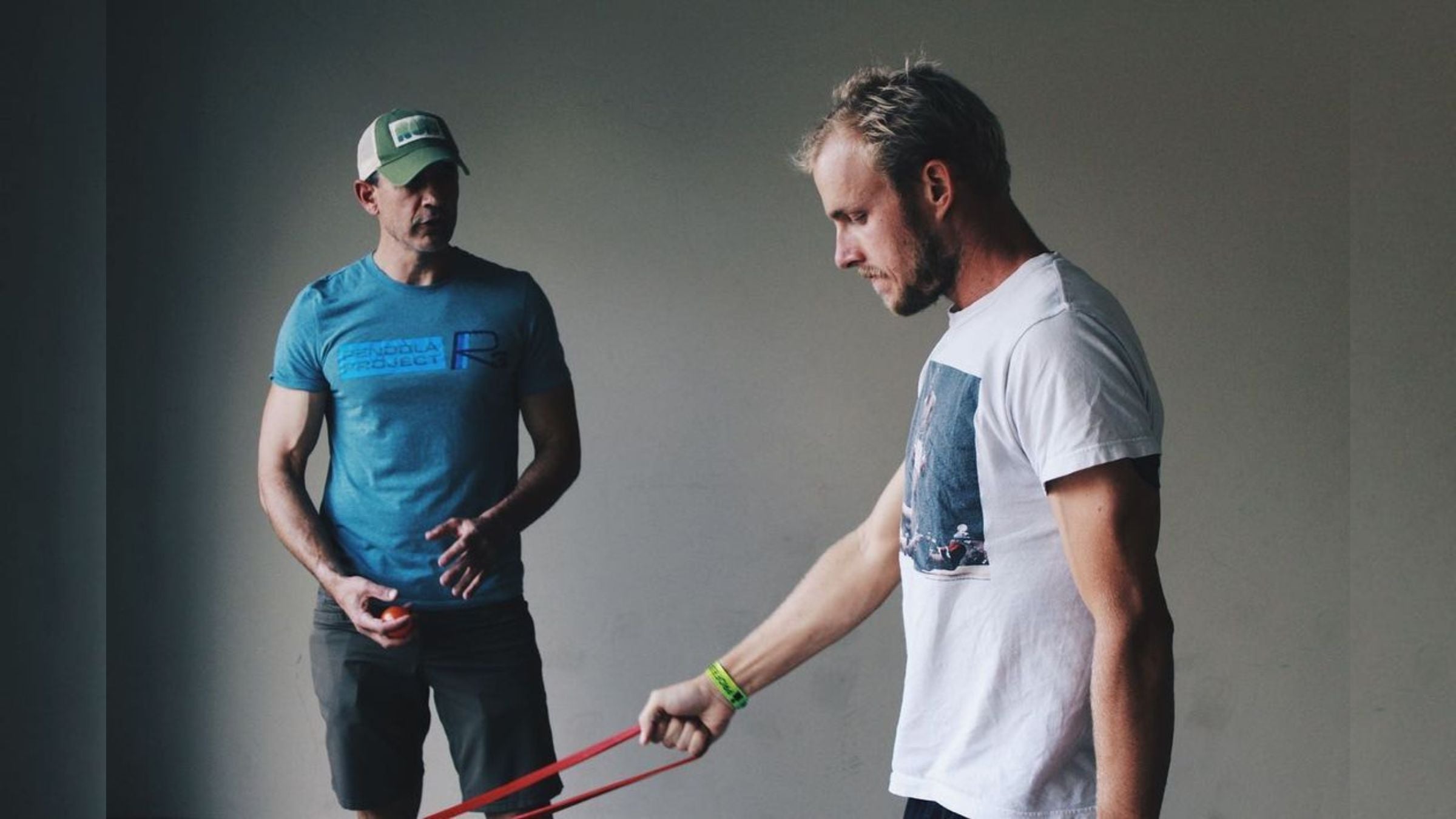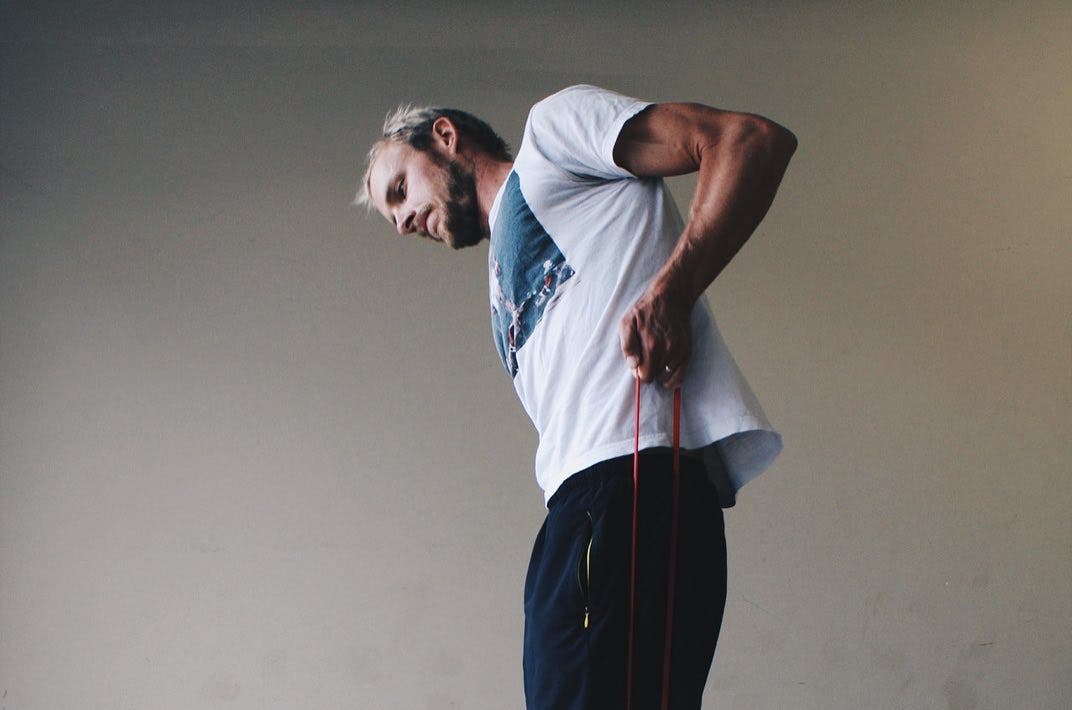The 30-Minute Mobility Routine That Helped Ben Kanute Nab His Second 70.3 World Championship Podium

(Photo: Pendola Project)
Mobility Drills for Triathletes
One month ago at 70.3 World Championships in St. George, American Ben Kanute did the unthinkable by challenging Norwegian Kristian Blummenfelt on the run in St. George. While he didn’t hang on for the win, his courageous display of running ability earned him respect from fans and competitors alike. Kanute owes his season-making second-place finish at 70.3 world in no small part to the work he’s done with his form and strength coach, Matt Pendola.
Lucky for us, Pendola was willing to share the mobility routine that Kanute used this year en route to a head-turning performance in St. George, in his own words:
“When you ask your body to perform a movement, like running, it will try its best to get the job done. If you have mobility restrictions, your body will pull mobility from areas that are supposed to be stable—a concept called compensation. Compensating for mobility restrictions is a huge risk factor for injury and poor performance, and may go unnoticed until it snowballs into a full-blown injury.
“A quality mobility routine is a quick and easy practice that is often undervalued or entirely overlooked in training. When we talk about mobility, we aren’t just talking about stretching tight muscles after a hard workout. A proper mobility routine will challenge you. It’ll ask you to stabilize through sport specific ranges of motion, so that when you go out to train, you’re actually moving better.
“The routine below has a 10-minute session for each of the disciplines, and can be done just about anywhere.”
RELATED: Ask a Trainer: Why Should Triathletes Care About Mobility?
The “Everything” Mobility Drill
Do this movement before all of your mobility sessions. Do 1 min. per side holding for 5 seconds at the bottom and midpoint.

How?
Start in a lunge position with your front foot forward. Place your opposite hand down next to your front foot. Extend your back leg while actively engaging your hips. Drop your free shoulder down and reach for the wall.
Pause for about 3-5 seconds while exhaling. Rebreathe while rotating. Reach for the sky for about 3-5 seconds while exhaling.
Why?
The Everything Mobility Drill improves your joint by joint ability to move free and efficiently. When you lack mobility in one area of your body, there is a chain reaction that can steal mobility from an area that should be stable (like your knee or lower back) via the aforementioned compensation method. This exercise will focus on much-needed mobility in areas like your ankle, hip, and thoracic (upper) spine to limit compensation.
RELATED: How to Build Hip Mobility Safely
Swim Mobility Drills
Roller Blades
Do 2 min. holding for 5 seconds at the midpoint.
How?
Start by stepping back from the wall enough so that you can apply pressure to the foam roll with your forearms parallel to each other and your palms facing each other. First, round your upper back, then reach with your hands and rotate your shoulder blades around your sides and up from 120-150 degrees while exhaling (cue credit to Eric Cressey). Hold for 3-5 seconds and return to the starting position.
Why?
Roller Blades improves your overhead position for swimming. Overdominant internal rotator shoulder girdle muscles can lead to suboptimal joint mechanics. This can weaken and fatigue important muscles like our serratus anterior that are responsible for the protraction and upward rotation of our scapula.
Hollow Rock Holds
Do 2 sets of 40 seconds holding for 5-10 seconds at the midpoint.
How?
Start by laying down on your back. Place a band around the arches of your feet. Squeeze a foam roller between your thighs and flex your trunk so that your lower back is smashing into the ground. Tuck your elbows in, breathe out while pressing overhead and spreading the band apart. Rebreathe through your nose. Breathe out while pressing your legs as far as possible without losing lower back flexion.
Why?
Hollow Rock Holds improves undulation for swimming. Swimmers tend to overextend their trunk, and full function from your limbs starts with optimal trunk stability. This exercise will fully engage your trunk flexors while extending your limbs.
Swimmer’s Pull Through
Do 2 sets of 40 seconds, holding for 5 seconds at the start and midpoint.
How?
Start by standing with some slack in the band. Place your hands inside the band with your thumbs facing back. Step back until you have appropriate tension on the band. Breathe in while folding your hips and push your butt behind you (like when you are closing the car door with grocery bags in your hands). Extend your upper back while you reach to get a long lat stretch. Rebreath through your nose and hold for 5 seconds. Breathe out while pulling through with straight arms and extending the hips to a standing position. Connect the tension from your hips to your shoulders without allowing your ribs to flair out. Hold this top position for 5 seconds while rebreathing through your nose.
Why?
Swimmer’s Pull Throughs strengthen your stroke—this sport specific mobility not only lengthens and strengthens your latissimus dorsi, it also focuses on stability through your entire posterior chain.
RELATED: Essential Tests and Exercises for Better Hip Mobility (And Happier Hamstrings)

Bike Mobility Drills
Start with your Stack
Do 1 min. per side holding for 5 seconds at the bottom and midpoint.
How?
Start barefoot with the band placed under the arches. Breathe out while pulling on one side (laterally flexing), getting your wrist to your ribs while reaching down with the opposite side. Hold this position without letting your ribs flare out for 5-10 seconds while rebreathing through your nose. Repeat on opposite side
Why?
This movement improves your ability to move from the top down more effectively. This lateral mobility strengthens your oblique and hip hikers to prevent your hips from asymmetrically shifting side to side.
Reverse Nordics
Do 2 sets of 40 seconds, holding for 5-10 seconds at the midpoint.
How?
Start by kneeling down and placing your ankles on a pad. Connect by extending your hips and squeezing your armpits without letting your ribs flare out. Breathe out while slowly descending backward. The goal is to find uninhibited pain free range without shifting our hips or spilling our spine. Hold for 5-10 sec while rebreathing and maintaining position. Fold the hips, sit, and return to the starting position.
Why?
Reverse Nordics improve your hip to knee efficiency. As we add more intensity or volume into our biking and running, areas that never seem to be a problem can suddenly become our biggest problem. This movement is also known as the “the human knee extension” because it will strengthen your knee stability while improving hip mobility and can be one of your best recovery tools.
Biker’s Athletic Anchor
Do 2 sets of 40 seconds, holding for 5 seconds at the start and midpoint.
How?
Start with feet shoulder-width apart. Breath in and keep the weight on your midfoot and your
knees in line with your toes as you sit back to a comfortable squat position. Breath out while you reach your arms overhead while maintaining a long strong spine as you spread the band apart. Breath in. Breath out as you lift your heels off the ground as high as possible, focusing on pushing your big toe down into the ground. Rebreathe as you hold for 5 seconds. Return your heels to the ground. Breath out as you push the ground away, driving your knees outwards as you come up from the squat, standing with terminal knee extension. Pull the band apart while maintaining a neutral spine. Hold for 5 seconds.
Why?
Biker’s Athletic Anchor improves pedal power. This compound movement gives us mobility through the ankles, hips, and upper back while challenging stability through our feet, knees, and trunk.
RELATED: A Simple Mobility Routine for Happy Joints
Run Mobility Drills
Foot Function
Do 1 min. per side holding for 5 seconds at the midpoint.
How?
Start by placing your hands shoulder width apart on the wall in front of you. Step back until you feel your calf stretch without letting your heel lift off the ground. Bring one leg forward to the wall while maintaining full foot contact with your grounded leg. Bring your floating leg across your midline without letting your back heel spin out or leave the ground. Breathe out and in through your nose while stretching your calf in this inverted heel position for 5-10 sec. Return to start position and repeat.
Why?
Foot Function improves running propulsion. Tight calves can prevent us from being able to use our springs effectively. This active stretch will get the ankle joint moving winding up the arch with the dorsiflexion we need to propel forward.
Side Shuffles
Do 2 sets of 7 dynamic reps on each side.
How?
Start in a wide stance width. Sit back while breathing out. (Practice by holding onto something in front of you.) Your hip must go back before your knee goes forward. Keep your lead knee behind the toe on the same side with your arms out in front of you. Repeat on the opposite side. Side shuffle for three quick steps and repeat movement.
Why?
Side shuffles improve groin reflex. Centripetal forces while running can make our groin and deep calf muscles feel sore and tight. This dynamic mobility drill addresses the ballistic nature of our running and improves elasticity.
Balance Blades
Do 1 min. per side of slow and controlled reps.
How?
Imagine you are in the center of a big clock. Your goal is to perform slow, controlled single leg reps around the clock.
Start on a single leg. Keep even pressure on the tripod of your foot (big toe, little toe, heel). Always initiate action by hinging your hips first.
1st position: Reach with your floating leg back while breathing out to 6 o’clock, leading with the opposite shoulder and arm like when you’re running. Touch your toe down lightly on the ground like it’s “thin ice” that you don’t want to break through. Return to start while breathing in with your nose.
2nd position: Reach to 7:30-8 o’clock.
3rd position: Reach to the side to 3 o’clock.
4th position: Reach to the front to 12 o’clock.
Why?
Balance Blades build up coordination and control for smooth running. Our body moves in a contralateral system to store and release energy. For example, your left shoulder moves with your right hip, your right elbow moves with your left knee, and your left ankle moves with your right wrist. This proprioceptive drill focuses on counter-rotation throughout the body to reduce unwanted or excessive motion.
RELATED: This Unconventional Race-Week Mobility Set Will Prime You For Success








